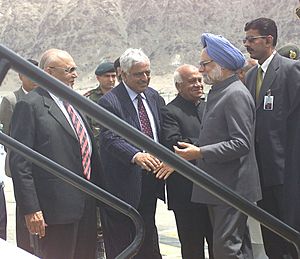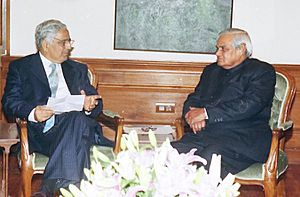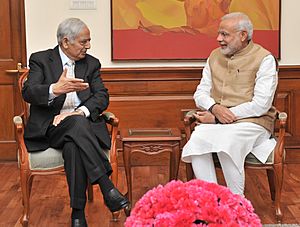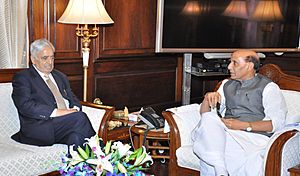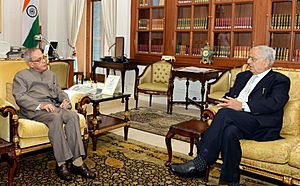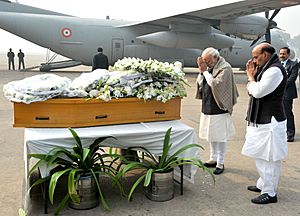Mufti Mohammad Sayeed facts for kids
Quick facts for kids
Mufti Mohammad Sayeed
|
|
|---|---|
 |
|
| 6th Chief Minister of Jammu and Kashmir | |
| In office 1 March 2015 – 7 January 2016 |
|
| Governor | Narinder Nath Vohra |
| Deputy | Nirmal Kumar Singh |
| Preceded by | Omar Abdullah |
| Succeeded by | Mehbooba Mufti |
| In office 2 November 2002 – 2 November 2005 |
|
| Governor | Girish Chandra Saxena Srinivas Kumar Sinha |
| Preceded by | Governor's rule |
| Succeeded by | Ghulam Nabi Azad |
| Minister of Home Affairs | |
| In office 2 December 1989 – 10 November 1990 |
|
| Prime Minister | V. P. Singh |
| Preceded by | Sardar Buta Singh |
| Succeeded by | Chandra Shekhar |
| Minister of Tourism | |
| In office 12 May 1986 – 14 July 1987 |
|
| Prime Minister | Rajiv Gandhi |
| Preceded by | HKL Bhagat |
| Succeeded by | Jagdish Tytler |
| Member of Parliament, Lok Sabha | |
| In office 1998–1999 |
|
| Preceded by | Mohammad Maqbool Dar |
| Succeeded by | Ali Mohammed Naik |
| Constituency | Anantnag |
| In office 1989–1991 |
|
| Preceded by | Dharamvir Singh Tyagi |
| Succeeded by | Naresh Kumar Baliyan |
| Constituency | Muzaffarnagar |
| Personal details | |
| Born | 12 January 1936 Bijbehara, Kashmir and Jammu, British India |
| Died | 7 January 2016 (aged 79) New Delhi, Delhi, India |
| Political party | Jammu and Kashmir Peoples Democratic Party |
| Other political affiliations |
Jammu & Kashmir National Conference (1950–1965) Indian National Congress (1965–1987, 1991–1999) Janata Dal (1987–1991) |
| Children | 4 (including Mehbooba Mufti, Tassaduq Hussain Mufti, and Rubaiya Sayeed) |
| Alma mater | Aligarh Muslim University |
Mufti Mohammad Sayeed (born January 12, 1936 – died January 7, 2016) was an important Indian politician. He came from the state of Jammu and Kashmir. He served as the Chief Minister of Jammu and Kashmir two times. This is like being the head of the state government.
He also held big jobs in the national government. He was the Minister of Tourism and later the Home Minister of India. The Home Minister is in charge of internal security and law enforcement. Mufti Sayeed started his own political party, the People's Democratic Party (PDP). His daughter, Mehbooba Mufti, now leads this party.
Contents
Early Life and Education
Mufti Sayeed was born in 1936 in a town called Bijbehara. This town is in the Anantnag district of Kashmir. His family had a background in religious studies.
He went to school in Srinagar for his early education. Later, he studied law and earned a postgraduate degree in Arabic from Aligarh Muslim University. After finishing his studies, he decided to enter politics. His daughter, Mehbooba Mufti, also became a politician and a Chief Minister of Kashmir.
Political Journey and Party Changes
Mufti Sayeed began his political career in the 1950s. He joined a group called the Democratic National Conference. This group later merged with the main Jammu & Kashmir National Conference party.
In 1962, he was elected to the state assembly from Bijbehara. When G. M. Sadiq became Chief Minister in 1964, Sayeed was made a Deputy Minister.
In 1965, his party joined the Indian National Congress. This made Sayeed a member of the Congress party. By 1972, he became a cabinet minister and led the Congress party in the state.
In 1986, he joined the national government under Prime Minister Rajiv Gandhi. He served as the Minister of Tourism. In 1987, he left the Congress party to join a new party called Jan Morcha. This led to him becoming the first Muslim Home Minister of India from 1989 to 1990.
He later rejoined the Congress party. But in 1999, he left again with his daughter, Mehbooba Mufti. Together, they started their own party, the Jammu and Kashmir Peoples Democratic Party.
Serving as Chief Minister
First Term: 2002 to 2005
In the 2002 state elections, Mufti Sayeed's Peoples Democratic Party won 18 seats. He then formed a coalition government with the Indian National Congress. He became the Chief Minister of Jammu and Kashmir for a three-year term.
During his time, a special police group was merged with the regular Jammu and Kashmir Police. His term also saw peace efforts between India and Pakistan. This led to the Line of Control (LOC) being opened for trade and bus services.
Second Term: 2015 to 2016
In the 2014 Jammu and Kashmir Legislative Assembly election, the PDP became the largest party. However, it did not win enough seats to form a government alone. So, the PDP formed a coalition with the BJP. Mufti Sayeed began his second term as Chief Minister in 2015.
Union Minister for Home Affairs
In 1989, soon after becoming the Union Minister for Home Affairs, a difficult event occurred. His third daughter, Rubaiya Sayeed, was kidnapped. She was later released in exchange for the release of five people. During his time as Home Minister, the Exodus of Kashmiri Hindus also took place.
Challenges and Family Safety
Mufti Sayeed faced challenges during his political career. Besides the kidnapping of his daughter, he also survived attacks on his own life. These attacks were carried out by groups seeking to separate Kashmir.
Death and Legacy
On December 24, 2015, Mufti Sayeed was admitted to a hospital in New Delhi. He was suffering from neck pain and fever. His health got worse, and he was put on a machine to help him breathe. He passed away on January 7, 2016, due to multiple organ failure. He was just five days short of his 80th birthday.
Many important leaders expressed their sadness at his death. These included Prime Minister Narendra Modi and the 14th Dalai Lama. He was buried with state honors in his family burial ground in Bijbehara. His daughter, Mehbooba Mufti, was supported by his party to become the next Chief Minister.
Mufti Mohammad Sayeed is laid to rest in Dara Shikoh Garden Bijbehara.
See also
 In Spanish: Mufti Mohammad Sayeed para niños
In Spanish: Mufti Mohammad Sayeed para niños
- 2014 Jammu and Kashmir Legislative Assembly election
- List of chief ministers of Jammu and Kashmir
- Jammu and Kashmir Peoples Democratic Party


